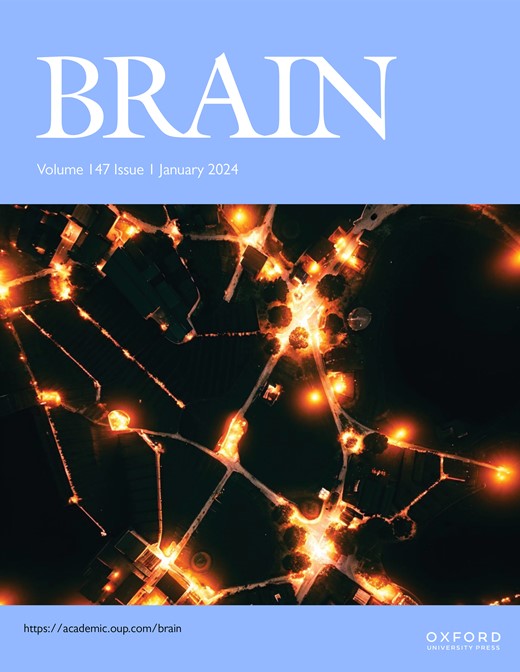Raised intracranial pressure alters cortical vascular function and cephalic allodynia
IF 10.6
1区 医学
Q1 CLINICAL NEUROLOGY
引用次数: 0
Abstract
Raised intracranial pressure (ICP) is associated with altered cerebral hemodynamics and cephalic pain. The relationship between the algetic response and cortical neurovascular changes in raised ICP is unclear. This study aimed to evaluate this relationship and determine if lowering ICP (using a glucagon like peptide-1 receptor agonist) could ameliorate the algetic response. We also sought to explore the role of calcitonin gene-related peptide in cephalic pain driven by raised ICP by inhibiting calcitonin gene-related peptide signalling and quantifying changes in the algetic response. In a rat model of raised ICP, created by intracisternal kaolin injection, mechanical thresholds were measured alongside steady-state potential and cerebral blood flow responses to spreading depolarisation. Nuclear magnetic resonance spectroscopy evaluated energetic substrates in animals with raised ICP ex-vivo. Glucagon like peptide-1 receptor agonist exenatide and calcitonin gene-related peptide receptor antagonist olcegepant were injected daily and measurements were repeated. Kaolin increased ICP [median (range) 15.96mmHg (8.97) n = 8] versus controls [6.02mmHg (1.79) n = 6 p = 0.0007]. Animals with raised ICP exhibited reduced mechanical thresholds (mean (SD) hind paw baseline: 5.78g (2.81), day 7: 3.34g (2.22) p < 0.001, periorbital baseline: 6.13g (2.07), day 7: 2.35g (1.91) n = 12 p < 0.001). Depolarisation and repolarisation durations were increased [depolarisation raised ICP: 108.81s (222.12) n = 11, controls: 37.54s (108.38) n = 9 p = 0.038, repolarisation raised ICP: 1824.26s (3499.54) n = 12, controls: 86.96s (140.05) n = 9 p<0.0001]. CBF change was also reduced (85.55% (30.84) n = 9) compared to controls (217.64% (37.70) n = 8 p < 0.0001). Substrates for cellular energetics (ADP, ATP and NAD+) were depleted in rodent brains with raised ICP (p = 0.009, p = 0.018, p = 0.011 respectively). Exenatide significantly lowered ICP (exenatide: 9.74mmHg (6.09) n = 19, vehicle: 18.27mmHg (6.67) n = 16 p = 0.004) and rescued changes in mechanical withdrawal. Exenatide recovered characteristic spreading depolarisation responses (depolarisation duration exenatide: 56.46s (25.10) n = 7, vehicle: 115.98s (58.80) n = 6 p = 0.033) [repolarisation duration exenatide: 177.55s (562.88) n = 7, vehicle: 800.85s (1988.67) n = 6 p = 0.002]. In the setting of raised ICP olcegepant prevented changes in periorbital mechanical thresholds. We conclude that raised ICP disrupted the cortical neurovascular responses, reduced algetic thresholds and depleted crucial energetic substrates. Exenatide reduced ICP, improving algetic thresholds and cortical neurovascular changes. Importantly, olcegepant alleviated the cerebral algesia, suggesting calcitonin gene-related peptide’s role in driving pain responses in elevated ICP. These studies support the rationale that reducing ICP improves cephalic pain in conditions of raised ICP. Furthermore, the data suggests that headache pain, in diseases associated with raised ICP, could be therapeutically ameliorated though blockade of the calcitonin gene-related peptide pathway.颅内压升高会改变大脑皮层的血管功能和头颅异感症
本文章由计算机程序翻译,如有差异,请以英文原文为准。
求助全文
约1分钟内获得全文
求助全文
来源期刊

Brain
医学-临床神经学
CiteScore
20.30
自引率
4.10%
发文量
458
审稿时长
3-6 weeks
期刊介绍:
Brain, a journal focused on clinical neurology and translational neuroscience, has been publishing landmark papers since 1878. The journal aims to expand its scope by including studies that shed light on disease mechanisms and conducting innovative clinical trials for brain disorders. With a wide range of topics covered, the Editorial Board represents the international readership and diverse coverage of the journal. Accepted articles are promptly posted online, typically within a few weeks of acceptance. As of 2022, Brain holds an impressive impact factor of 14.5, according to the Journal Citation Reports.
 求助内容:
求助内容: 应助结果提醒方式:
应助结果提醒方式:


